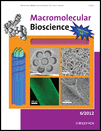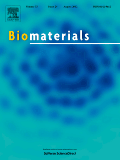
Materials
Scope & Guideline
Fostering collaboration in the evolving landscape of materials science.
Introduction
Aims and Scopes
- Nanomedicine and Drug Delivery Systems:
The journal extensively covers research on nanoparticles, liposomes, and other nanostructured systems designed for targeted delivery of therapeutics, enhancing the efficacy and reducing the side effects of treatments. - Tissue Engineering and Regenerative Medicine:
Research articles frequently explore the development of scaffolds, hydrogels, and other biomaterials aimed at regenerating damaged tissues and organs, with a focus on enhancing cell proliferation and differentiation. - Biocompatibility and Bioactivity of Materials:
A significant focus is placed on the interactions between materials and biological systems, emphasizing the importance of biocompatibility, the immune response, and the modulation of cellular behaviors to improve therapeutic outcomes. - Smart and Responsive Materials:
The journal features studies on materials that respond to environmental stimuli (e.g., pH, temperature, light) for controlled drug release, enhanced imaging, and other applications in biomedicine. - Photothermal and Photodynamic Therapies:
Innovative materials for photothermal and photodynamic therapies are a prominent theme, with research aimed at utilizing light-activated systems for cancer treatment and other therapeutic applications. - Microphysiological Models and Organ-on-a-Chip Technologies:
The journal publishes research on the development of microfluidic systems and organ-on-a-chip models to study disease mechanisms and drug responses in a physiologically relevant context.
Trending and Emerging
- Targeted and Personalized Medicine:
There is a notable increase in research focused on developing targeted therapies and personalized medicine approaches, utilizing materials that can specifically interact with patient-specific biomarkers or tumor microenvironments. - Immunotherapy and Immunomodulation:
Emerging studies are increasingly exploring the intersection of materials science and immunotherapy, focusing on materials that can modulate the immune response to enhance therapeutic efficacy against cancers and other diseases. - Smart Biomaterials and Bioelectronics:
Research on smart biomaterials that incorporate electronic properties for real-time monitoring, drug delivery, and tissue engineering is on the rise, reflecting advances in bioelectronics and their applications in healthcare. - Sustainable and Green Materials:
There is a growing emphasis on the development of sustainable materials derived from natural sources or designed to be biodegradable, aligning with global trends towards environmental sustainability in biomedical applications. - In Vivo Imaging and Diagnostic Technologies:
Studies focusing on materials that enhance imaging capabilities for diagnostics, particularly using advanced imaging techniques such as NIR-II fluorescence and photoacoustic imaging, are trending, indicating a shift towards integrating materials with diagnostic technologies.
Declining or Waning
- Traditional Biomaterials without Functionalization:
Research focused solely on traditional biomaterials, such as inert polymers, without exploring their functionalization or integration with biological systems appears to be declining. There is a growing trend towards more sophisticated, bioactive, and responsive materials. - Conventional Drug Delivery Methods:
Papers on conventional drug delivery methods that do not incorporate nanotechnology or advanced materials are becoming less frequent, as the field shifts towards more innovative, targeted, and controlled release systems. - Non-Engineered Natural Biomaterials:
The use of unmodified natural biomaterials without any engineering or enhancement is seeing a decrease, as researchers increasingly prioritize the customization and optimization of materials for specific biomedical applications. - Basic Mechanical Properties Studies:
Studies focusing solely on the mechanical properties of materials without linking them to specific biomedical applications or outcomes are less common, as the emphasis shifts towards functional performance in biological contexts.
Similar Journals

International Journal of Biomaterials
Advancing healthcare through innovative biomaterials research.The International Journal of Biomaterials, published by HINDAWI LTD, is a premier platform for disseminating groundbreaking research in the fields of biomaterials and biomedical engineering. With an Open Access approach since 2009, this journal provides unhindered access to innovative studies and applications aimed at advancing medical technologies and improving patient outcomes. Notably ranked in the Q3 category for both Biomaterials and Biomedical Engineering in 2023, it serves as an essential resource for researchers, practitioners, and students alike. The journal's Scopus rankings, including a 49th percentile in Biomedical Engineering and a 40th percentile in Biomaterials, further underscore its growing prominence in the academic community. With contributions spanning from 2011 to 2024, the journal seeks to foster collaborative research and promote developments that enhance the understanding and application of biomaterials in healthcare.

Bioactive Materials
Exploring the Intersection of Science and BioengineeringBioactive Materials, published by KEAI PUBLISHING LTD, stands as a leading Open Access journal in the fields of Biomaterials, Biomedical Engineering, and Biotechnology. Since its inception in 2016, this journal has rapidly ascended in prominence, currently holding a prestigious Q1 category ranking across multiple disciplines, reflecting its significant impact within the scientific community. With its E-ISSN 2452-199X, it spans a broad spectrum of research areas, contributing valuable insights to the ongoing discourse in bioactive materials and their applications. The journal's superior Scopus rankings further illustrate its influence, boasting impressive standings in engaging niches such as engineering and molecular biology. Bioactive Materials offers a vital platform for researchers, professionals, and students to disseminate and acquire cutting-edge knowledge, thus fostering innovation and collaboration in the rapidly evolving terrain of biomedicine. Its commitment to Open Access since 2016 enhances accessibility, ensuring that the burgeoning advancements in this field reach a global audience.

CELLS TISSUES ORGANS
Bridging Knowledge Gaps in Anatomy and Histology.CELLS TISSUES ORGANS is a renowned academic journal published by KARGER, focusing on pivotal research within the fields of Anatomy and Histology. Based in Switzerland, this journal has been disseminating influential scientific findings since 1889, contributing to our understanding of cellular structures and tissue functionality. With a current impact factor that places it in the Q2 quartile for both disciplines, it serves as a vital resource for researchers, professionals, and students seeking to stay abreast of significant advancements and discussions in these areas. The journal embraces an Open Access model, ensuring that high-quality, peer-reviewed articles are freely available, thus enhancing visibility and accessibility of critical research. As it continues to foster scholarly communication and innovation up to 2024, CELLS TISSUES ORGANS plays a crucial role in shaping the future of biological sciences and medical research.

Materials Science & Engineering C-Materials for Biological Applications
Transforming health through cutting-edge material solutions.Materials Science & Engineering C-Materials for Biological Applications is a premier journal published by ELSEVIER, dedicated to advancing the field of biomaterials through interdisciplinary research. With a robust ISSN of 0928-4931, this journal has made its mark in the realms of Chemical Engineering and Materials Science, achieving impressive Scopus rankings within its categories, namely Rank #16/151 in Bioengineering (89th percentile) and Rank #13/112 in Biomaterials (88th percentile). Although the journal's coverage in Scopus has been discontinued since 2021, it remains a critical resource for researchers, professionals, and students eager to explore innovative materials and their applications in biological contexts. The journal’s open access policy enhances its accessibility, fostering a global exchange of knowledge and inspiring future advancements in the field of materials science.

Biomedical Materials
Innovative Insights for Enhanced Patient Care.Biomedical Materials, published by IOP Publishing Ltd, is a premier journal dedicated to the rapidly evolving field of biomedical engineering and materials science. With a robust impact factor showcasing its influence, this journal serves as a vital platform for disseminating pioneering research from 2006 to 2024. Covering an array of interdisciplinary topics—ranging from biomaterials to bioengineering and applied chemistry—the journal consistently ranks in the second quartile across multiple categories including Bioengineering (Q2), Biomaterials (Q2), and Biomedical Engineering (Q2) as of 2023. Researchers, professionals, and students alike benefit from its contributions, exploring innovative solutions at the intersection of biology and material science. Although not an Open Access journal, Biomedical Materials remains essential in advancing our understanding and facilitating discussions surrounding state-of-the-art materials that revolutionize medical applications and enhance patient care.

Biomaterials Research
Unveiling the potential of biomaterials for healthcare.Biomaterials Research, published by the American Association for the Advancement of Science, is a prominent open access journal established in 2014, dedicated to advancing the field of biomaterials. Based in the United Kingdom, this journal has swiftly become an essential platform for researchers and practitioners, offering groundbreaking insights in biomaterials, biomedical engineering, ceramics and composites, and miscellaneous medical fields. With its impressive Q1 ranking across multiple relevant categories in 2023 and its strong Scopus rankings, including a remarkable 90th percentile in the medicine category, Biomaterials Research showcases high-quality, peer-reviewed research designed to address both practical and theoretical challenges in biomaterials science. As an open access journal, it promotes wider dissemination and accessibility of research findings, crucial for fostering innovation and collaboration within the scientific community. Researchers, professionals, and students alike are encouraged to contribute, read, and engage with the latest developments in this dynamic field.

MACROMOLECULAR BIOSCIENCE
Advancing the Frontiers of Macromolecular InnovationMACROMOLECULAR BIOSCIENCE, published by WILEY-V C H VERLAG GMBH, is a leading journal in the fields of bioengineering, biomaterials, biotechnology, materials chemistry, and polymers and plastics. With a convergence of scientific inquiry since its inception in 2001, the journal has established itself as a vital resource for researchers and professionals exploring the interface of molecular sciences and biosystems. It boasts impressive Scopus rankings, including Q1 status in multiple categories, reflecting its significant contribution to advancing knowledge and innovation in the polymer and biomaterials domains. While the journal does not currently offer open access options, its rigorous peer-review process ensures the publication of high-quality research that fuels academic discourse. Positioned in Weinheim, Germany, MACROMOLECULAR BIOSCIENCE aims to bridge theoretical understanding with practical applications, making it an essential reference for students, academics, and industry practitioners dedicated to the evolving landscape of macromolecular bioscience.

Cellular and Molecular Bioengineering
Unleashing Potential: Where Molecular Biology Meets EngineeringCellular and Molecular Bioengineering, published by SPRINGER, is a prominent journal dedicated to the exploration of interdisciplinary approaches in the fields of biochemistry, genetics, and molecular biology. With an ISSN of 1865-5025 and an E-ISSN of 1865-5033, this journal has been a pivotal resource since its inception in 2009, showcasing groundbreaking research that combines innovative modeling and simulation techniques with cellular and molecular applications. As a Q2 journal in both Biochemistry, Genetics and Molecular Biology (miscellaneous) and Modeling and Simulation categories, it ranks favorably in the Scopus metrics, placing 62nd out of 324 in Mathematics_ Modeling and Simulation, and 69th out of 221 in General Biochemistry, Genetics and Molecular Biology. The journal's commitment to quality research and its contribution to advancing academic dialogue make it essential for researchers, professionals, and students seeking to stay at the forefront of bioengineering innovation. While it currently does not offer open access, it continues to provide significant insights and empirical studies that can help shape future developments in the field, reinforcing its role as a key player in cellular and molecular bioengineering.

BIOMATERIALS
Transforming Ideas into Advanced Biomaterials SolutionsBIOMATERIALS, published by Elsevier Science Ltd, is a premier academic journal dedicated to the interdisciplinary field of biomaterials research. With an impressive impact factor, it ranks in the Q1 quartile across multiple categories including Bioengineering, Biomaterials, and Biophysics, showcasing its significance in advancing scientific knowledge. Established in 1980 and set to converge its discussions through 2025, this journal provides a critical platform for researchers and professionals to disseminate their findings on the development, application, and performance of biomaterials. The journal covers a wide range of topics, from the mechanics of materials to nanotechnology, and is highly regarded with top Scopus rankings in essential categories, including an exceptional position within the 99th percentile for Biophysics. Although not an open access journal, BIOMATERIALS remains vital for students and established researchers alike, ensuring accessibility to groundbreaking research in the field. Engage with cutting-edge studies that pave the way for innovative applications in medicine, engineering, and beyond.

Journal of Materials Chemistry B
Transforming Ideas into Innovations in Materials Science.Journal of Materials Chemistry B is a prestigious peer-reviewed journal published by the Royal Society of Chemistry, specializing in the latest advancements in the realm of materials chemistry. With a profound impact in the scientific community, this journal has achieved impressive Q1 quartile rankings in 2023 across several categories, including Biomedical Engineering, Miscellaneous Chemistry, Materials Science, and Medicine, illustrating its pivotal role in interdisciplinary research. Its impressive Scopus rankings further emphasize its widespread recognition, with notable placements in the top percentiles for various fields. Covering a broad scope of topics from novel materials for biomedical applications to innovative chemical synthesis techniques, the journal aims to promote knowledge exchange and foster collaborative research across disciplines. Although not an open-access journal, it offers a platform for researchers to share their findings and contribute to the evolving discourse within materials science. With a publication record spanning from 2013 to 2024, the Journal of Materials Chemistry B remains an essential resource for researchers, professionals, and students dedicated to exploring the frontiers of materials chemistry.